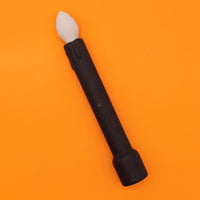We may be in 2023, but sex education really doesn’t cover even the basics when it comes to female pleasure. Saddening it may be, the sphere of sex education tends to focus more on pregnancy, contraception and STIs when it comes to female sexual health, rather than any inclusion of pleasure, what signs to look out for in unhealthy relationships, and other important factors to having a pleasurable and healthy sex and love life.
Looking back at history, it’s no wonder that we’re so confused when it comes to female pleasure. Think of ideas pushed by Sigmund Freud and the sexual revolution during the Victorian era — where female pleasure and masturbation was shameful, yet it was speculated that you needed an orgasm to conceive, and laws and restrictions made life pretty rough for women (but that’s a whole other story). And, although there have been complexities to the differences in how female pleasure has been viewed throughout history and in different cultures, as a whole, it has largely been misunderstood.
Because of this lack in sex education, and the fact that most men find sex pleasurable each time, there are hundreds of common myths about female pleasure. In order to debunk some of the most common myths about women's pleasure, we spoke with Dr. McElligott (OB/GYN, MD, MPH), NAMS Certified Menopause Practitioner, and Medical Advisor at Mira.
Why do people have myths and misconceptions about female pleasure?
Myths about female sexuality have existed since the earliest human societies, explains Dr. McElligott. Nowadays, talking about sex has become less of a taboo, but it remains a controversial topic often avoided in female sexual education. Women's health company Mira has recently conducted the survey on the state of sex education in the USA which focused on over 1500 Americans aged between 18 and 44, and found that only 32% of females report receiving information about sexual pleasure during formal sex education, compared to 51% of males.
While the amount of research on sexual arousal is growing, it is challenging to study arousal and sexuality in general, which means there is still a lot that we do not know. And obviously, wherever knowledge is absent, misconceptions creep in to fill the gap.
In order to debunk ten of the most common myths around female pleasure, Dr McElligott expanded on some misconceptions, explaining why they are, in fact, myths.
1. The use of the term “vagina” as a term to encompass female genitalia
The vagina is the canal between the vulva and the interior reproductive organs. Using the term vagina is not recommended as it is not only inaccurate but suggests that the only important part of the female genitalia is the part intended for penetration. The term Vulva is the accurate term for female external genitalia.
2. The clitoris is a small nub
Female and male reproductive organs originate from the same embryonic cells. The clitoral tissue arises from the same cells as the penis, and when it’s aroused, it grows. The small nub that is visible is called the glans of the clitoris (analogous to the glans of the penis). The rest of the clitoris is below the surface and traces back towards the vagina. In total, the clitoris is about 16mm in length.
3. Women should be able to orgasm on penetration alone
Penetration is just one small aspect of female sexual function and pleasure. In fact, only around 30% of healthy women orgasm reliably with intercourse. There are many different ways that a woman can orgasm, including through stimulation of the anus, nipples, cervix and clitoris. Some women find that they orgasm through the stimulation of one of these areas alone, whilst others need a combination of several to reach climax. A study showed that little as 4% of women experience an orgasm from penetration alone.
4. Lubrication is a signal of a woman's enjoyment of sexual intercourse
There is a long-standing misconception about what a genital response indicates. Just as drooling at the sight of a lemon is a response to something food-relevant, female and male genitals respond to anything sexually relevant, regardless of their interest or enjoyment. Lubrication is a physiologic response to something sexually relevant, and not an indicator of whether someone is enjoying sexual intercourse.
5. It is normal for sex to hurt
Pain before, during, or after sex is not normal. While discomfort may occasionally occur the first time a female has sex, or in some positions, persistent pain should never be ignored. If you’re experiencing pain throughout sex, especially when it's consistent, you should speak to a doctor. This could be a sign of an underlying condition.
6. There is a “normal” way for the vulva to look
Vulvas vary in size and shape. If the anatomy of a female’s vulva is not causing pain, it is normal. The pornography industry has set a standard for the appearance of the vulva that is not an accurate representation of what is “normal”.
7. All women have a hymen
Some women have a hymen, but not all. The hymen is a thin layer of tissue that adheres to the vaginal wall. The hymen is not always “breakable” as it is not usually a barrier. The hymen most commonly forms a ring around the vagina that can stretch. In some females, the hymen is not visible because it is very thin or absent. The hymen also has very few blood vessels. Bleeding during sexual intercourse is more likely to occur from general trauma to vaginal tissues than from the hymen itself.
8. Since men often feel a spontaneous desire for sex, women should too
The female sexual arousal system is more often sensitive to context (the physical environment, stress, etc.), and therefore, the frequency and timing of their desire for sex differ from males.
9. Sex is not “good” unless it ends in orgasm
Sexual enjoyment goes beyond the physical, and orgasm is not required for it to be enjoyed. Sometimes, sex can simply be about sharing an incredibly intimate moment with your partner. Medication can also have a huge impact on whether you experience an orgasm. For instance, SSRIs (antidepressants) can prevent women from experiencing orgasm, and so can stress factors, trauma, and many other reasons. If you don’t end with an orgasm, this isn’t a bad thing.
10. Masturbating means you are not sexually interested in your partner, and using toys is harmful
Masturbation is a normal, natural act of sexuality and can improve intimacy with your partner. It is not a sign of sexual disinterest in someone else. Sometimes, partners will feel threatened by their significant other using a sex toy, assuming that this means they aren’t interested in sex with them. In fact, studies have shown that the use of sex toys can actually enhance and improve sex lives for women.




















































